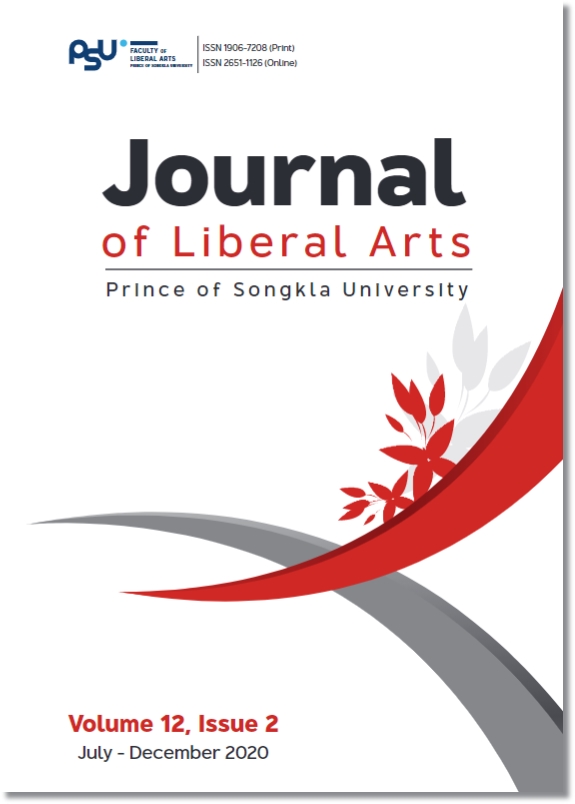A Comparison of Borrowed Words in the Shan Language
Keywords:
Comparison, Borrowing words, Shan LanguageAbstract
This linguistic research is a comparative study on three groups of borrowings in the Shan language, which comprise Burmese borrowings, Pali-Sanskrit borrowings, and English borrowings. The aim of this study was to compare how these groups of borrowings are adopted in Shan, their characteristics, and factors related to their adoption. The sources of this comparative study included a Shan-English Dictionary, a Picture Dictionary, a Shan-Thai Dictionary, and Thai-Shan Dictionary. In this research, various word borrowing methods were identified, i.e. transliteration using the origin source-language word order (found in the three groups of borrowings), transliteration using the Shan word order (in Burmese and English borrowings), borrowing words through Burmese (in Pali-Sanskrit borrowings), translation of borrowings (in English borrowings), and defining new words (in English borrowings). The most common borrowing method is transliteration. Concerning their characteristics, the three groups of borrowings consist of single words, compounds formed between words from the same language, compounds which are formed between borrowings and Shan words, and compounds which are formed between borrowings. Most of the borrowings are single words. The factors related to adopting these borrowings consist of politics (found in Burmese and English borrowings); religions and beliefs (in all the three groups of borrowings); education and academic matters (in all the three groups); modernity and technology (in all the three groups); environmental proximity (in Burmese borrowings); and western culture (in English borrowings). However, the most common factors are religions and beliefs, followed by education and academic matters, and politics, respectively.
References
Chiang Mai Rajabhat University. (2009). Tai Yai (Shan)-Thai dictionary. Chiang Mai: Chiang Mai Rajabhat University. [in Thai]
Jantanakom, W. (1983). Characteristics of Tai Yai (Tai O) in Mae Sai District, Chiang Rai Province [Master’s dissertation, Silpakorn University]. Nakhon Pathom, Thailand. [in Thai]
Khanthaphad, P. (2016). Loanwords in Shan language: English. Journal of Humanities and Social Science, Burapha University, 24(45), 159-175. [in Thai]
Khanthaphad, P. (2017). Pali- Sanskrit borrowings in Shan language. Journal of Social Science Humanities and Arts, Silpakorn University, 37(2), 177-195. [in Thai]
Kingkham, W. (2013). Foreign languages in Thai (2nd ed.). Kasetsart University Press. [in Thai]
La-ongsri, K. (1985). Hometown of Thai. Art and Culture Publishing. [in Thai]
Office of the Royal Society. (2014). Linguistic words dictionary (Applied Linguistics) (2nd ed.). Office of the Royal Society. [in Thai]
Office of the Royal Society. (2011). Thai dictionary. Office of the Royal Society. [in Thai]
Pongpaiboon, S. (1988). The principal of Thai languages. Thai Watthanaphanit Publishing. [in Thai]
Saengponsit, W. (1981). Foreign languages in Thai. Bangkok: Odeon Store. [in Thai]
Santasombat, Y. (2000). Lak Chang: New creation of Tai identity in Dehong. Amarin Book Center. [in Thai]
Shan Buddhist Monks. (2514). Thai-Shan dictionary. Mahachulalongkorn rajavidyalaya University. [in Thai]
Sao Tern Moeng. (1995). Shan-English dictionary. DP Dunwoody Press.
Shan Culture and Education Central Committee (SCEC). (2002). Picture dictionary. NHEC.
Sirithon, P. (1985). Above region of Siam. Chang Peuak Publishing. [in Thai]
Terwiel, B.J., & Diller, A. (1990). Native Thais were not here. Muang Boran Publishing. [in Thai]
Wichasin, R. (2003). Knowing and reading Shan script. Department of Thai, Faculty of Humanity, Chiang Mai University, Thailand. [in Thai]
Downloads
Published
How to Cite
Issue
Section
License
The authors retain the copyright to their article but the Journal of Liberal Arts, Prince of Songkla University reserves the exclusive rights to first publication.






